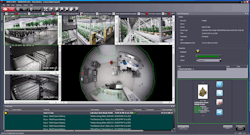How video surveillance can keep an eye on your supply
Cannabis operators are facing increasing security threats ranging from armed robbery, and break-ins to cyber breaches and employee theft. No matter what level of the supply-chain these operators fill (and often the same company holds licenses in multiple sectors), investment in video security is not only vital to the safety of the operation but plays a key role in applying for and maintaining a state license. The common practice is to think of security as simply a cost center which is a necessary evil to get started in the industry. However, technology is currently being used to allow operators to extend this security investment into operational effectiveness to realize more practical business optimization with integration into other security platforms, track and trace software and environmental sensors. In this article, we will review best practices for security design as well as ways to extend the required investment in video security from compliance to operational effectiveness.
Security Technology in Canna
When it comes to securing your cannabis facility, compliance is key. Not all security consultants are the same, in fact, many of these professionals lack experience in the cannabis industry which is highly regulated and varies state-by-state. It is strongly recommended to work with a consultant and/or systems integrator who has experience doing design-build work in the cannabis sector in your specific state. These professionals understand the unique requirements, pitfalls and caveats and more importantly, they are more likely to work with security product manufacturers that cater to your needs. Security professionals understand that design work changes by vertical market, e.g., the security threats/conditions for a cannabis cultivator are vastly different than those of a casino, or K-12 school district. When your license is on the line, this experience can make the difference in safety and business continuity.
Technology is available that allows intrusion, fire, access control and video to be managed by one software application to give you video verification on your overall security environment. This information is tagged and cataloged with time/date-stamping for future reference when and if it is required. Real-time events like after-hour access to the site, people loitering in or around the facility, are being sent to operators as push notifications on their phone where video of the event can be accessed on-demand. Video analytics are affordable and effective to focus the user's attention on the most important details of the operation including who is entering the facility. This can be done through a combination of object detection, license plate recognition, face recognition and access control.
Extending your Video Security Investment
Cannabis operators are finding that the investment in security which is a requirement for licensing can be extended without additional equipment costs to include proactive measures to protect employees and products. A trend for distribution and dispensary operators is to re-purpose the video surveillance infrastructure into live monitoring by third-party specialty companies without disrupting the end-users’ day-to-day access to the cameras.
For additional safety to employees and an active deterrent against theft, facilities are utilizing video monitoring centers for live video monitoring with “talk-down” audio for proactive protection. These services work with the existing security platform so no additional product purchase is required. For a monthly fee that depends on factors such as total daily monitoring time (i.e., 8 am-8 pm), the number of live call-downs per day to notify that the facility is under active surveillance, and employee open/close procedure, operators can outsource their security detail to trained professionals that actively monitor alarms from their video analytics-based system.
Extending your Video Security investment: Track and Trace
There are two major components to most state-mandated compliance programs regardless of which sector of the market operators focus on. The first, which we have covered extensively above, is security by design with a focus on video coverage, resolution, frames per second, and the number of days of retention. This is by far the most consistent theme when it comes to securing cannabis facilities for state compliance. The other major component to state-mandated compliance programs is what is known as Track-and-Trace. This type of regulation is interested in tracking the plant from the moment it is closed until it is sold into the market to the end consumer and operators are required to log information such as the weight of the product at various stages of production, transportation and sales process. The majority of states use a software application called METRC which is a compliance management solution used by regulatory bodies for the oversight of the cannabis industry. This cloud-based software is required for reporting all cannabis-related products throughout the supply chain.
Each plant is issued a unique identifier plant tag that will follow the plant from immature status through the cultivation process, manufacturing, distribution and eventual sale. cannabis operators are required to use METRC to report key data points to the state and this reporting is vital to the success of the state-legal cannabis program.
As important as METRC is to successful compliance for licensees, it is strictly a reporting tool required by the state that provides little operational value to operators. As the cannabis industry continues to grow and expand from state to state, the demand for more user-friendly business application software that could also serve the need for track-and-trace has increased. This class of software, which is collectively known as seed-to-sale, can be described as part of warehouse management, part point of sale and part enterprise resource planning. Seed-to-sale has in large part become the key day-to-day interface for the operator where they can manage all facets of the business while effectively fulfilling their reporting requirement for state compliance. Plant tag bar-codes or RFID are scanned into the software as the product is processed through its life cycle which in-turn reports this information to METRC. Aside from state reporting, seed-to-sale is also used for inventory and grow management throughout the supply chain.
Maintaining proof of chain of custody is vital to protecting the legal cannabis supply as it moves from cultivation to eventual sale in the designated adult-use or medical program. Savvy operators have learned that it is possible to “integrate” their seed-to-sale software applications into their video security software. By doing this, every time a plant tag is scanned, the data pulled from the plant tag into the seed-to-sale software is also sent to the video management software which tags this metadata with video from the corresponding camera viewing the scene. This metadata then becomes searchable reference points in the video archive. If there is ever any question by state compliance inspectors about
the integrity of the chain of custody while the product was inside the facility, all related video to that plant tag ID number can be quickly accessed by simply adding this number into the keyword search. Additional information that can be logged in the video metadata includes the plant strain name, individual who handled the plant event, location inside the facility (i.e., trimming room) and the type of action taken (i.e., plant-weigh event). All of these data points can be used to search for video at a later date.
Extending your Video Security investment: Environmental Sensors
Cannabis cultivators use many different types of environmental sensors to help manage their grow operations. Facilities often deploy state-of-the-art technology to minimalize anomalies that could affect the yield and potency of the final product. Grow operations are grand scientific labs where data plays a key role in the success of production. Temperature, humidity, water-flow, and carbon dioxide are all carefully monitored to make sure the levels fall within safe ranges designated by the cultivation team.
There are many products in the market that use software to manage these sensors and centralize this information to one platform through building automation that can control lights, irrigation and electrical consumption.
Video security can also play a key role in helping operators monitor these important environmental sensors. Similar to centralizing events from seed-to-sale software, exceptions from the environmental sensor platforms can be sent to the video management software when specific thresholds are exceeded. This integration can range from low voltage interchange such as a dry contract output to an input- triggered event or through more sophisticated software integration through a CGI interface over a TCP/IP network. Practical uses for integration between environment sensors into video security include triggering PTZ cameras to move to presets when sensor events occur. By doing this, operators can extend their investment in video security from a cost center to a potential operation saving application in the rare case where crops are damaged or lost due to equipment malfunction that would be detected by the environmental sensor. This tie to video security can also play a crucial role in assisting insurance claims when product or property suffers damage.
Video Security is one of the most important aspects of the legal cannabis business. It plays a vital role in state compliance programs and is a required element for successfully attaining and maintaining a valid license for all phases of the supply chain. When selecting video security technology, it is important for operators to understand that there are options that can extend their investment from a pure cost center to improved overall operational effectiveness. Many cannabis operators are implementing video management software that can not only protect their assets and personnel but also interact with both seed-to-sale software and environmental sensors by tagging video with searchable metadata. This co-operation between platforms allows users to easily search and find video based on what is important to the security profile, the event.
About the author: Steve Birkmeier is Vice President of Sales and Business Development at Arteco. Steve has worked in sales, marketing, and business development for over 15 years. Over half of this time has been dedicated to the Physical Security Industry, playing a key role in building the North American Sales Division of Arteco Global. As Vice President of Sales Operations, he is responsible for Sales Force Management, OEM Relationships, Sales Channel Development, Distribution Channels, Partner Programs, and Business Development.Most recently Steve has focused on expanding International Markets for the company, growing business penetration in Canada, Central America, South America, the Caribbean, South Africa and Australia.
About the Author
Steve Birkmeier
vice president, sales and business development
Steve Birkmeier is vice president of sales and business development for Arteco

